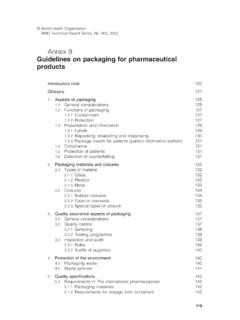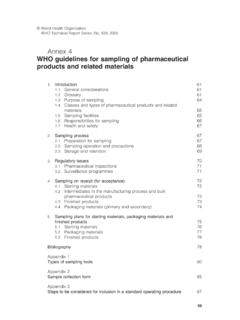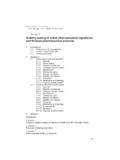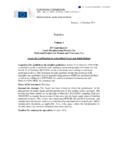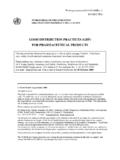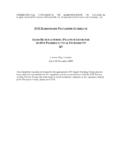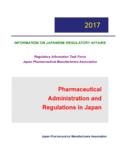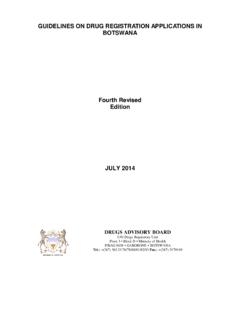Transcription of Guidelines for good clinical practice (GCP) for trials on ...
1 World Health OrganizationWHO Technical Report Series, No. 850, 1995, Annex 3 Guidelines for good clinical practice (GCP) for trials onpharmaceutical products*INTRODUCTIONG lossary AND PREREQUISITES FOR A clinical for the data for the investigational and site(s) of requirements PROTOCOL OF TRIAL of committee OF THE care of trial of trial with the for subjects and informed investigational trial of the trial or submission to the drug regulatory by an ethics adverse events or , auditing and and handling of of and accountability for pharmaceutical products for of in which the investigator is the sponsor OF THE of the Investigator(s) of responsibilities with the protocol and product Safety management and handling of operating for subjects and of adverse of trial OF THE of the trial education and of the trial or submission to the regulatory OF and recording adverse adverse events AND HANDLING OF of the of the sponsor and the of data AND and OF AND ACCOUNTABILITY FOR pharmaceutical and labelling and packaging of the of the sponsor and the OF THE DRUG REGULATORY ASSURANCE FOR THE CONDUCT OF A clinical FOR MULTICENTRE TRIALSREFERENCESAPPENDIX Medical Association s Declaration ofHelsinkiAPPENDIX list of items to be contained in a clinical trial protocolAPPENDIX 3.
2 Considerations for multicentre trials_____* This text was developed in consultation with national drug regulatory authorities within WHO sMember States. It was also discussed during two informal consultations convened by theDivision of Drug Management and Policies, WHO, Geneva, from 26 to 27 June 1991 and 29 Juneto 3 July 1992. The participants were: Ms M. Cone, International Federation of PharmaceuticalManufacturers Associations (IFPMA), Geneva, Switzerland; Professor P. Dayer, InternationalUnion of Pharmacology (IUPHAR), Brussels, Belgium; Professor I. Darmansjah, University ofJakarta, akarta, Indonesia; Dr Dunne, Director, Division of Drug Management and Policies,WHO, Geneva, Switzerland (Joint Secretary); Dr Y. Hirayama, New Drugs Division, Ministry ofHealth and Welfare, Tokyo, Japan; Professor E.
3 Hvidberg, University Hospital, Copenhagen,Denmark (Chairman); Dr J. Id np n-Heikkil , Associate Director, Division of Drug Managementand Policies, WHO, Geneva, Switzerland (Joint Secretary); Mr R. Laderman, Center for DrugEvaluation and Research, Food and Drug Administration, Bethesda, MD, USA; Professor , Russian State Center for Drug Expertise, Moscow, Russian Federation; Dr P. Maurice,Ciba-Geigy, Basel, Switzerland; Professor Pobee, School of Medicine, Lusaka, Zambia;Mr M. Tsukano, New Drugs Division, Ministry of Health and Welfare, Tokyo, Japan; Dr , Medical Products Agency, Uppsala, Sweden; Professor A. Zanini, Institute ofBiomedical Science, S o Paulo, Brazil; Professor Zhu Jun-Ren, Shanghai Medical University,Shanghai, purpose of these WHO Guidelines for good clinical practice (GCP) for trials onpharmaceutical products is to set globally applicable standards for the conduct of suchbiomedical research on human subjects.
4 They are based on provisions already promulgated in anumber of highly developed countries including Australia, Canada, European Communitycountries, Japan, Nordic Countries (Denmark, Finland, Iceland, Norway and Sweden) and theUnited States. These Guidelines inevitably vary somewhat in content and emphasis, but all areconsonant with regards to the prerequisites to be satisfied and the principles to be applied as abasis for assuring the ethical and scientific integrity of clinical trials . Indeed, they have provideda formal basis for mutual recognition of clinical data generated within the interested care has been taken, in developing the WHO Guidelines as a practicable administrativetool for use by WHO s Member States, to assure their compatibility with existing national andother provisions.
5 It is hoped, on the basis of further consultation, to seek formal acceptance ofthe Guidelines by Member States as a contribution to harmonization of national standards and tofacilitating movement of pharmaceutical products internationally. No question arises, however,of challenging or replacing existing national regulations or requirements. The objective is toprovide a complementary standard that can be applied worldwide. In countries where nationalregulations or requirements do not exist or require supplementation, relevant governmentofficials may designate or adopt, in part or in whole, these Guidelines as the basis on whichclinical trials will be Guidelines are addressed not only to investigators, but also to ethics review committees, pharmaceutical manufacturers and other sponsors of research and drug regulatory providing a basis both for the scientific and ethical integrity of research involving humansubjects and for generating valid observations and sound documentation of the findings.
6 TheseGuidelines not only serve the interests of the parties actively involved in the research process,but protect the rights and safety of subjects, including patients, and ensure that the investigationsare directed to the advancement of public health Guidelines are intended specifically to be applied during all stages of drug developmentboth prior to and subsequent to product registration and marketing, but they are also applicable,in whole or in part, to biomedical research in general. They should also provide a resource foreditors to determine the acceptability of reported research for publication and, specifically, of anystudy that could influence the use or the terms of registration of a pharmaceutical product .
7 Notleast, they provide an educational tool that should become familiar to everyone engaged inbiomedical research and, in particular, to every newly-trained definitions given below apply specifically to the terms used in this guide. They may havedifferent meanings in other eventAny untoward medical occurrence in a clinical trial subject administered a pharmaceuticalproduct; it does not necessarily have a causal relationship with the reactionA response to a pharmaceutical product that is noxious and unintended and which occurs atdoses normally used or tested in man for prophylaxis, diagnosis, or therapy of disease, or for themodification of physiological function. In clinical trials , injuries caused by overdosing, abuse ordependence and interactions with any other product should be considered adverse of a trialA systematic examination, carried out independently of those directly involved in the trial, todetermine whether the conduct of a trial complies with the agreed protocol and whether the datareported are consistent with the records on site, whether data reported or recorded in thecase-report forms (CRFs) are consonant with those found in hospital files and other -report form (CRF)A document that is used to record data on each trial subject during the course of the trial, asdefined by the protocol.
8 The data should be collected by procedures which guaranteepreservation, retention and retrieval of information and allow easy access for verification, auditand trialA systematic study on pharmaceutical products in human subjects (including patients and othervolunteers) in order to discover or verify the effects of and/or identify any adverse reaction toinvestigational products, and/or to study the absorption, distribution, metabolism and excretion ofthe products with the object of ascertaining their efficacy and trials are generally classified into Phases I to IV. It is not possible to draw distinct linesbetween the phases, and diverging opinions about details and methodology do exist. A briefdescription of the individual phases, based on their purposes as related to clinical developmentof pharmaceutical products, are given below:Phase IThese are the first trials of a new active ingredient or new formulations in man, often carriedout in healthy volunteers.
9 Their purpose is to establish a preliminary evaluation of safety, anda first outline of the pharmacokinetic and, where possible, a pharmacodynamic profile of theactive ingredient in IIThese trials are performed in a limited number of subjects and are often, at a later stage, of acomparative ( placebo-controlled) design. Their purpose is to demonstrate therapeuticactivity and to assess short-term safety of the active ingredient in patients suffering from adisease or condition for which the active ingredient is intended. This phase also aims at thedetermination of appropriate dose ranges or regimens and (if possible) clarification of dose-response relationships in order to provide an optimal background for the design of extensivetherapeutic IIIT rials in larger (and possibly varied) patient groups with the purpose of determining the short-and long-term safety/efficacy balance of formulation(s) of the active ingredient, and ofassessing its overall and relative therapeutic value.
10 The pattern and profile of any frequentadverse reactions must be investigated and special features of the product must be explored( clinically-relevant drug interactions, factors leading to differences in effect such as age).These trials should preferably be of a randomized double-blind design, but other designs maybe acceptable, long-term safety studies. Generally, the conditions under which thesetrials are carried out should be as close as possible to normal conditions of IVStudies performed after marketing of the pharmaceutical product . trials in phase IV arecarried out on the basis of the product characteristics on which the marketing authorizationwas granted and are normally in the form of post-marketing surveillance, or assessment oftherapeutic value or treatment strategies.











